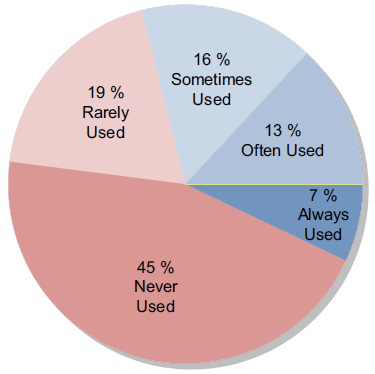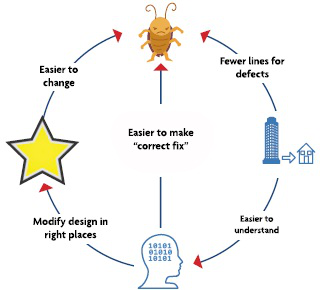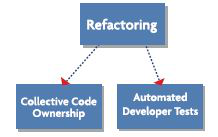To successfully adopt Agile practices let's start by answering the question "which ones first?" Once we have a general idea of how to choose the first practices there are other considerations. Then, once you've chosen the first practices that best fit your environment, you and your team(s) will need to be aware of the mindset you'll need to get the most out of the practices you choose.
Choosing a Practice to Adopt
Choosing a practice comes down to finding the highest value practice that will fit into your context. Figure 4 contains practices that help improve the quality that your software development team(s) builds. Figure 4 will also guide you in determining which practices are most effective in increasing the quality of your software and will also give you an understanding of the dependencies. The other parts in this section discuss other ideas that can help you refine your choices. Armed with this information:
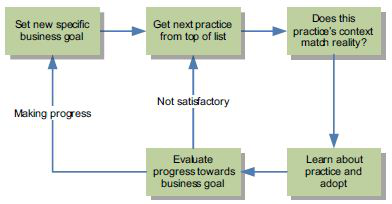
Figure 4: Steps for Choosing and Implementing Practices
For improving quality, the set of practices that will give you the most value are those nearest the top of Figure 1. Four of the practices are independent: done state, automated developer tests, automated acceptance tests, and pair programming. Consider adopting pair programming as a support practice to the other three practices, then take them on one or two at a time. Next on your list (or maybe even concurrent) to consider should be done state and automated developer tests, and then finally automated acceptance test (probably the most difficult of this set to adopt correctly).
The Mindset
Be Disciplined, Confront Issues, Respond Positively to Pain
The practices involved in improving the quality to market are some of the most difficult to do from the body of Agile practices. Things will get harder before they get easier. The first rule is to expect the difficulty, be patient, and don't stop the practices just because they uncover significant problems; be disciplined in your practice. Once you start a practice give it a chance because you will slow down and confront frustrations before speeding up. For example, pair programming is frequently seen as a waste of resources and uncomfortable to many developers who are used to (and enjoy) working alone. Consider giving it a chance by agreeing as a team to practice pair programming for a couple of months before deciding whether it is worth adopting permanently.
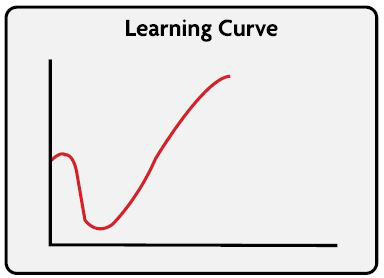
Figure 5: Learning Curve
Figure 5 The J-curve is what to expect when adopting new practices. First things will be hard and you will be less productive; stay with it and it will improve.
Confront issues when they come up instead of stopping a practice because it is 'too painful'. Deal with pain differently than you are used to; instead of discontinuing something painful, examine it and find the source. Often Agile practices will uncover problems that have always been there but have not been felt. Feeling the pain is a chance to correct a problem and improve towards your goal of increased quality. A good example of this happens when teams start adopting done states for the first time. There is no partial credit, either you are 100% done or 0% done. A team that adopts this for the first time frequently works on multiple features at a time and at the end of the iteration they have not fully completed any of the features. Therefore they are 0% done with all of their tasks. This is discouraging and painful and a common response is to stop doing the practice instead of examining the pain and looking for alternatives to correct the problems in the next iteration.
Get Good at Small Steps
Small steps are going to save your life with these practices because many are completely new ways of doing things that may slow you down and frustrate you as you are learning them. Take one practice, do it well, and do it regularly. You might consider pair programming along with any and all of the practices to make it easier and keep you on-track. How do you know you are doing a practice well? You get the value that you originally hoped to get - i.e. the quality of your software noticeably increases. You also have confronted pains and learned from them. If a practice is completely easy and comfortable from the get-go, or has not noticeably improved the quality of your work then you probably are not done yet.
Be Prepared to "Suspend Your Disbelief"
Much of what you will be doing will not make immediate sense. It will feel that you are doing things that are more trouble than they are worth. For example writing your tests first, before writing your code in the automated developer tests practice is non-intuitive. What can you possibly gain by doing things backward? Those who have successfully adopted this practice have "suspended their disbelief" and done it anyway. After experientially learning the practice they then made their judgments about its utility and usually kept doing it because they saw the value.
Know What You Don't Know
The Dreyfus Model of Skill Acquisition, is a useful way to look at how we learn skills such as learning Agile practices necessary to improve quality. It is not the only model of learning, but it is consistent, has been effective, and works well for our purposes. This model states that there are levels that one goes through as they learn a skill and that your level for different skills can and will be different. Depending on the level you are at, you have different needs and abilities. An understanding of this model is not crucial to learning a skill; after all, we've been learning long before this model existed. However, being aware of this model can help us and our team(s) learn effectively.
So let's take a closer look at the different skill levels in the Dreyfus Model:

Figure 6 The Drefyus Model for skill acquisition. One starts as a novice and through experience and learning advances towards expertise.
How can the Dreyfus Model help in an organization that is adopting agile methods? First, we must realize that this model is per skill, so we are not competent in everything. Secondly, if Agile is new to us, which it probably is, then we are novices or advanced beginners; we need to search for rules and not break them until we have enough experience under our belts. Moreover, since everything really does depend on context, and we are not qualified to deal with context as novices and advanced beginners, we had better get access to some people who are experts or at least proficient to help guide us in choosing the right agile practices for our particular context. Finally, we'd better find it in ourselves to be humble and know what we don't know to keep from derailing the possible benefits of this new method. And we need to be patient with ourselves and with our colleagues. Learning new skills will take time, and that is OK.







